
| What is Flavor and Fortune? |
| How do I subscribe? |
| How do I get past issues? |
| How do I advertise? |
| How do I contact the editor? |
Read 13009957 times
Connect me to:
| Home |
| Articles |
| Book reviews |
| Letters to the Editor |
| Newmans News and Notes |
| Recipes |
| Restaurant reviews |
| Article Index (all years, slow) |
| List of Article Years |
| Article Index (2025) |
| Article Index (last 2 years) |
| Things others say |
| Related Links |
| Log In... |
| Authors |
| Categories & Topics |
Tea Ceremony Classes
| by Jacqueline M. Newman |
Beverages
Spring Volume: 2010 Issue: 17(1) page(s): 36 and 37
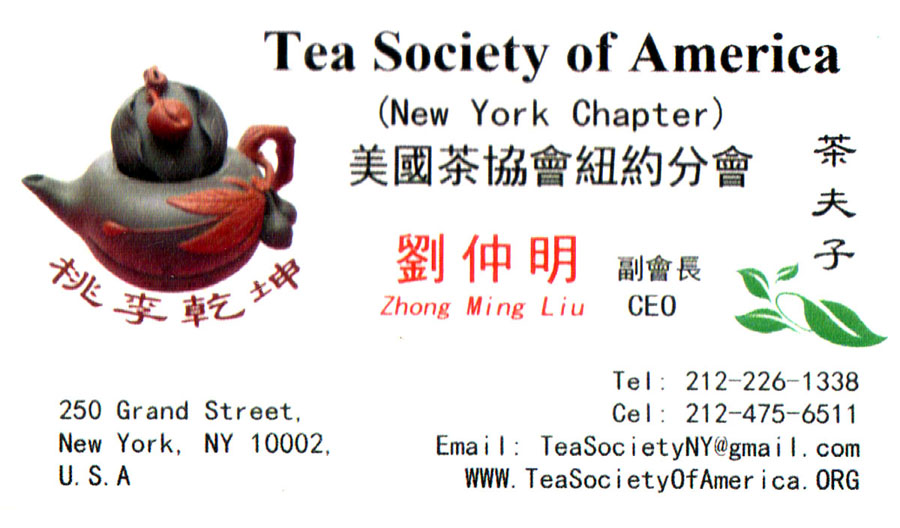 A special program, known locally as SEYS or Summer Youth Employment Program ran last summer. These classes were also sponsored by the Tea Society of America's New York Chapter. The one we observed was teen-agers earning how to conduct these ceremonies with Mr. Zhong Ming Lin, the CEO, instructing this unique series of classes.
A special program, known locally as SEYS or Summer Youth Employment Program ran last summer. These classes were also sponsored by the Tea Society of America's New York Chapter. The one we observed was teen-agers earning how to conduct these ceremonies with Mr. Zhong Ming Lin, the CEO, instructing this unique series of classes.
Most students, but not all, were from Chinatown. One young lady came from Nassau County, most were female, and there was one man in the group. However, he was absent the day we visited. All were excited to learn and practice this ancient art, all dressed the part, and all tried to do the ceremony perfectly. We thought them poised and perfect, albeit a mite nervous, but we were their first public audience.
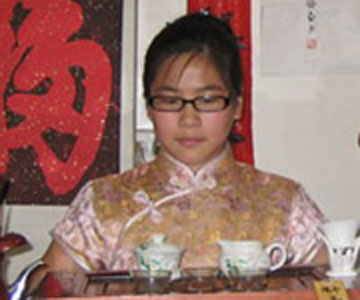 We witnessed five different though related ceremonies, each student performing a different one. Each of them had every finger, hand, and motion in perfect control. They all started by offering a greeting and welcoming the audience. Then they introduced themselves and said they hoped we "would find the experience enjoyable and enlightening." We did!
We witnessed five different though related ceremonies, each student performing a different one. Each of them had every finger, hand, and motion in perfect control. They all started by offering a greeting and welcoming the audience. Then they introduced themselves and said they hoped we "would find the experience enjoyable and enlightening." We did!
Each student showed the 'dry tea display plate' and we admired that tea in its dry form. They pointed to the 'tea strainer' and 'tea strainer shelf' telling us that these were there to catch stray leaves from the cup or teapot and hold the strainer, respectively. They showed us the 'tea infuser,' also known as an 'equality cup' which is used to disperse flavor equally. 'Tea tasting cups' were shown and we admired color and aroma of the brew. Some presentations used a 'three layer cup' or saucer, cup, and cover. The meaning associated with these three items are: earth, mankind, and heaven, respectively. They symbolize harmony between earth, humankind, and heaven.
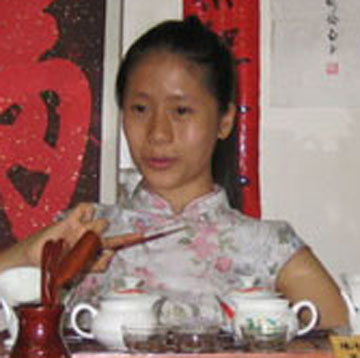 In every instance, they showed and shared all tea equipment items. We learned about the tea scoop, tongs, brush, needle, and tea funnel, the tea pot, tea cup, tea strainer, infuser, and rest for it. One of the latter was particularly gorgeous, its two hands pointed upward to hold the strainer. All pieces of equipment, the girls too, are shown in one or more pictures on this and the next page.
In every instance, they showed and shared all tea equipment items. We learned about the tea scoop, tongs, brush, needle, and tea funnel, the tea pot, tea cup, tea strainer, infuser, and rest for it. One of the latter was particularly gorgeous, its two hands pointed upward to hold the strainer. All pieces of equipment, the girls too, are shown in one or more pictures on this and the next page.
The audience learned about these ten items before they were used in a tea ceremony. Things began after boiling water was poured over everything. This they told us is to 'disinfect teapot, bowls, and cups.' The teapot is then raised on high, water flowing down from its spout, emulating water coming down from high mountains. This sets the mood providing a serene experience.
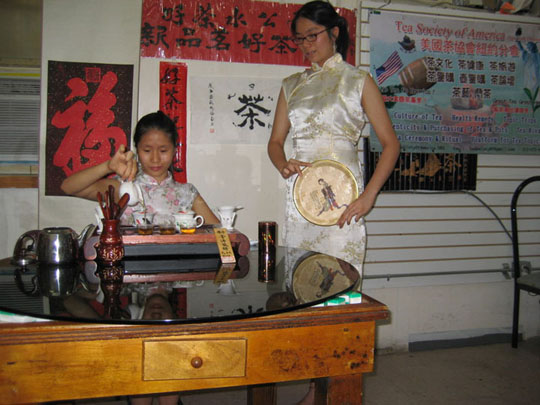 They introduced equipment speaking of 'tea tongs' aiding the utensils, 'tea scoop' taking tea out of its canister, 'tea needle' used to unclog a tea spout if/as needed, 'tea brush' sweeping the tea leaves into the teapot, and 'tea funnel' guiding them into the teapot. We learn that the process of sweeping tea leaves into the teapot symbolizes 'inviting royal officials into the palace.' After brushing them into the preheated pot, made so by filling it with boiling water, they pour more water over the filled teapot. This keeps temperature inside and out constant. Any excess water is poured into a waste container, which in some ceremonies is the wooden or stone shelf under the teapot. This is called a 'tea ocean.' Next, rinsing the tea leaves, an important step, washes dust from them.
They introduced equipment speaking of 'tea tongs' aiding the utensils, 'tea scoop' taking tea out of its canister, 'tea needle' used to unclog a tea spout if/as needed, 'tea brush' sweeping the tea leaves into the teapot, and 'tea funnel' guiding them into the teapot. We learn that the process of sweeping tea leaves into the teapot symbolizes 'inviting royal officials into the palace.' After brushing them into the preheated pot, made so by filling it with boiling water, they pour more water over the filled teapot. This keeps temperature inside and out constant. Any excess water is poured into a waste container, which in some ceremonies is the wooden or stone shelf under the teapot. This is called a 'tea ocean.' Next, rinsing the tea leaves, an important step, washes dust from them.
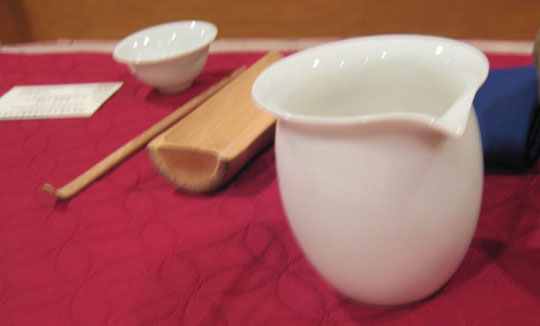 One pouring of the water is done three times to show the phoenix nodding three times with respect to the guests. After a second pouring of water over the leaves, the teapot cover is removed and passed around. This enables everyone to enjoy the captured aroma of the particular tea being prepared for tasting.
One pouring of the water is done three times to show the phoenix nodding three times with respect to the guests. After a second pouring of water over the leaves, the teapot cover is removed and passed around. This enables everyone to enjoy the captured aroma of the particular tea being prepared for tasting.
Shared this day were several tea ceremony experiences. One was a simple one, another a clay-pot tea ceremony, a third the three-piece teacup ceremony using cup, cover, and saucer below. The last one was a two teapot ceremony preparing two different teas simultaneously. This two different kinds of tea, one each in a different teapot, requires identical left and right hand movements to pour two teas, one from each pot, into the same cup at the same time. This gets each guest a mixed cup of two teas; and the ones done that day were of pu-er and green tea. They made a delightful and delicious combination.
For those who do not know, pu-er tea comes from the Yunnan Province in Southwestern China where year-round, the weather can be spring-like. The best quality is grown organically on thousand-year-old trees, and prized because, as time progresses, it is aged and its value increases. In this class, the pu-er tea leaves were not aged ones but those immediately processed after picking.
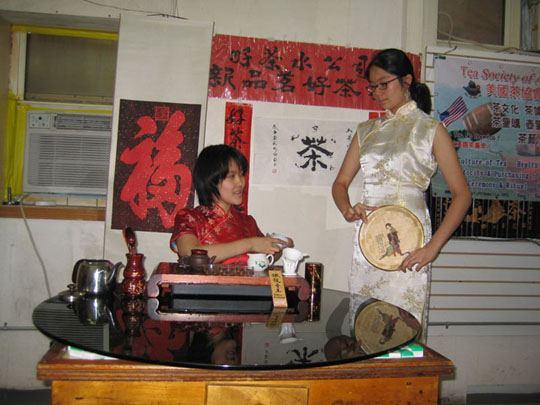 Each young woman, in each ceremony, used elegant and constrained hand movements, kept their fingers, hands, and wrists in perfect position, their bodies ramrod straight. They looked lovely in their Chinese silk high-slit dresses and their high heels.
The equipment varied. Sometimes it was clay, other times glass, and most often simply gorgeous porcelain. The latter, when not in use, is stored in a lovely silk-lined box. That box, many items of equipment, and the students practicing one or another tea ceremony are shown on this page.
Each young woman, in each ceremony, used elegant and constrained hand movements, kept their fingers, hands, and wrists in perfect position, their bodies ramrod straight. They looked lovely in their Chinese silk high-slit dresses and their high heels.
The equipment varied. Sometimes it was clay, other times glass, and most often simply gorgeous porcelain. The latter, when not in use, is stored in a lovely silk-lined box. That box, many items of equipment, and the students practicing one or another tea ceremony are shown on this page.
The teas tasted were perfectly brewed and delicious. Some tasted are green, others oolong or black, pu-er, or ti kwan yin; or a combination of any two of these.
The server hands each guest a cup of tea with two hands, and each guest accepts theirs, also with two hands. Then each raises the cup on high, bows, offers thanks, and enjoys a beautifully presented wonderful tea.
At this set of tea ceremonies, each of us learns that tea is mystical, and that drinking it raises the senses. It is truly a heavenly moment to enjoy the tea and be at peace with oneself and the world. A Chinese poem says: “Tea is the key to a calm and serene existence. It also promotes a healthy and active life.” Leaving this class, everyone felt calm looking forward to serene day, and a healthy and active life.
_____
Special thanks to Mr. Zhong Ming Liu, and to Karen, Alice, Christina, Tiffany, and Amy. Those who want to arrange similar lessons are invited to contact Mr. Liu by phone: (212) 475-6511, snail mail: 250 Grand Street, New York NY 10002: or e-mail at: teasocietyny@gmail.com

Copyright © 1994-2025 by ISACC, all rights reserved
Address
3 Jefferson Ferry Drive
S. Setauket NY 11720